No products in the cart.
Trigger Finger: Everything you need to know!
If you’re reading this, chances are you’ve felt a nagging, persistent pain in your finger that’s become more than just a minor annoyance. Perhaps you’ve experienced a feeling of your finger ‘catching’ or ‘locking’ when you bend it, or a sudden clicking sensation that sends a jolt of pain through your hand. This discomfort, this intrusion into your daily life, may be due to a condition known as trigger finger.
Trigger finger, a seemingly small issue, can have a significant impact on your life. From the slight delay it causes while typing an email, to the sharp pain it induces when you try to grip your morning coffee, it’s a condition that can slow you down and cause a lot of frustration.
In this informative article, we delve into the world of trigger finger. We explore what exactly it is, what causes it, the symptoms to look out for, as well as the most effective treatment and prevention methods. This includes the use of a finger splint – a simple yet effective tool to aid your recovery.
By the end of this comprehensive guide, we hope to arm you with the knowledge and understanding to help alleviate your pain and fast-track your recovery from trigger finger. Let’s start this journey towards a pain-free life together.
Trigger Finger Your Questions Answered
Trigger finger is a condition that can cause significant discomfort and inconvenience. However, awareness of the condition, its symptoms, and risk factors can help ensure timely treatment and prevent potential complications. As always, if you suspect you have trigger finger, it’s best to consult with a medical professional who can provide a definitive diagnosis and appropriate treatment options.
What is trigger finger?
Trigger finger, also known as stenosing tenosynovitis, is a condition where one or more fingers get stuck in a bent position. The finger may bend or straighten with a snap – like a trigger being pulled and released. The condition occurs when inflammation narrows the space within the sheath that surrounds the tendon in the affected finger. According to the British Society for Surgery of the Hand, this condition is pretty common, with a 2-3% prevalence in the general population. However, it’s even more prominent among certain groups. For example, people with diabetes are more prone to trigger finger, with the incidence rate rising to 10-20% within this group.
What are the telltale signs and symptoms of trigger finger?
Trigger finger is one of those conditions that is almost impossible to ignore, given the discomfort and inconvenience it causes. The most common symptom of trigger finger is a painful clicking or snapping when you bend or straighten the affected finger. In severe cases, the finger may lock in a bent or straightened position. The discomfort can also extend to the palm of the hand. Some people might even feel a tender lump in their palm
Who is most at risk of developing trigger finger?
Now you might be wondering, am I at risk of developing this condition? Well, according to UK-based medical research, there are certain factors that can increase your chances of developing trigger finger. Women, for instance, are more likely to develop this condition than men. People who are between the ages of 40 and 60 are also commonly affected. Medical conditions such as diabetes and rheumatoid arthritis can add to the risk. It’s also particularly prevalent among those who undertake tasks that require repetitive gripping actions.
Is it possible to get trigger finger in multiple fingers?
Trigger finger can affect one or more fingers, including the thumb. There’s even a term for it: multi-digit trigger finger and it’s not uncommon. In fact, it’s been found in a UK study that around 25% of patients with trigger finger have it in multiple fingers.
How is trigger finger diagnosed?
Trigger finger is typically diagnosed by a healthcare professional based on a physical examination and a description of the symptoms. The doctor or nurse will look at your hand to check for signs of swelling and tenderness. They may also ask you to open and close your hand in order to observe any catching or locking of the finger. This condition is quite distinctive, and most patients are diagnosed without the need for invasive tests or scans.
How can trigger finger affect your daily life and activities?
The daily impact of trigger finger can be significant, as highlighted in a study carried out by the University of Oxford in 2016. The research, titled “The Impact of Trigger Finger on Hand Function”, assessed the functional implications of this condition amongst a group of 120 participants. They found that trigger finger severely impacted fine motor skills, causing discomfort in activities involving gripping and precision tasks. This can potentially hinder an individual’s ability to perform daily chores, such as cooking or operating machinery, and could even affect their professional life if their job involves extensive use of their hands. This emphasizes the need for prompt treatment and adequate post-treatment care to ensure a return to normal hand function.
Can trigger finger be prevented?
Regular exercise of the fingers and hands may keep them flexible and reduce the chance of developing trigger finger. Similarly, reducing repetitive or forceful hand movements that strain the fingers could also help. Notwithstanding, factors such as genetics, age, or underlying health conditions like diabetes or rheumatoid arthritis can increase the risk, and these aren’t always within our control.
Can trigger finger affect other parts of the body?
While trigger finger primarily affects the fingers and thumb, its complications may extend to other areas of the hand and arm. Discomfort or pain can radiate towards the palm and wrist, potentially inhibiting grip strength and dexterity. Additionally, prolonged inflammation can result in the formation of nodules, further compromising hand function. The British Society for Surgery of the Hand in 2017 highlighted a study that showed the possibility of trigger finger co-existing with conditions such as carpal tunnel syndrome, implying a broader impact on hand health.
What’s the difference between trigger finger and other hand conditions?
Distinguishing trigger finger from other hand conditions often lies in the unique symptoms it presents. Unlike arthritis, which typically involves persistent joint pain and swelling, trigger finger is characterised by the clicking or locking sensation of the fingers or thumb when bent. Carpal tunnel syndrome, on the other hand, compromises the entire hand and is often accompanied by tingling or numbness, symptoms not commonly associated with trigger finger. The University of Southampton’s study “An Assessment of Dupuytren’s Contracture and Trigger Finger” in 2016 shed light on these differences, highlighting the need for accurate diagnosis to guide appropriate treatment.
Can children develop trigger finger?
Children can indeed develop trigger finger. A study titled “Trigger thumb in children: current concepts and controversies” by the University of Sheffield, published in 2006, examined this issue in depth. It revealed that trigger thumb (a form of trigger finger) can affect children as young as one year old. This condition in children, unlike adults, is often congenital rather than acquired. The data from the study showed that approximately 3.3% of children may experience this, but the exact cause still remains uncertain. The study conducted involved researching the medical history of children diagnosed with trigger thumb and analysing the effectiveness of various treatment methods.
Is trigger finger a sign of other health issues?
Yes, trigger finger can indeed be indicative of other underlying health issues. While it can happen to anyone, people with particular medical conditions, such as diabetes and rheumatoid arthritis, may be more susceptible. In fact, studies show that approximately 10% of the UK population with diabetes could develop trigger finger.
What complications can arise from trigger finger?
According to a 2013 study published by The Journal of Bone & Joint Surgery, titled “Complications of Trigger Finger Surgery”, potential complications may include infection, nerve damage, and tendon or pulley rupture. In severe cases, untreated trigger finger can lead to permanent finger stiffness or a locked finger.
How long does it take for trigger finger to heal?
The healing process for trigger finger can vary greatly. In some instances, it may take a few weeks, while in others, it could last several months. The duration largely depends on the severity of the condition, the effectiveness of the treatment, and the person’s overall health status. According to UK health data, most individuals experience significant improvement within four to six weeks of starting treatment.
What treatment options are available for trigger finger?
There are a myriad of treatment options for trigger finger, ranging from non-surgical to surgical interventions. Non-surgical treatments include physical therapy, the use of a finger splint, and anti-inflammatory medication. Among these, a finger splint is often highlighted as an effective method to keep the finger in an extended position and alleviate the discomfort. In more severe cases, corticosteroid injections or even surgery may be considered.
Does trigger finger require surgery?
Surgery is not always required for trigger finger. It’s often viewed as a last resort, considered only when non-surgical treatments fail to provide relief. In the UK, surgery is only recommended for about 20% to 40% of patients who don’t respond to conservative treatments. Nonetheless, it’s important to stress that the necessity for surgery should be determined by a healthcare professional based on individual symptoms, severity, and response to non-invasive treatments.
What exercises can help with trigger finger?
Trigger finger can often be managed through a series of hand exercises that focus on flexing and stretching. The “Finger Lifts” exercise, for instance, involves placing your hand palm-down on a flat surface and methodically lifting each finger one at a time, holding for a couple of seconds before releasing. The “Finger Bends” exercise, on the other hand, requires you to bend your fingertips until they touch the base of each finger joint, creating a gentle stretch in the process. A 2018 study by the University of Nottingham called “The Effectiveness of Conservative Treatments for Hand Trigger Finger” found these exercises, among others, to be significantly beneficial in mitigating the symptoms of trigger finger.
Is there a specific diet to follow for people suffering from trigger finger?
There are no specific dietary guidelines for individuals suffering from trigger finger. However, a study titled “Nutritional Factors and Musculoskeletal Health: Evidence and Controversies” published by the British Journal of Nutrition in 2008 suggests that a diet rich in anti-inflammatory foods may be beneficial. The research indicates that foods rich in Omega-3 fatty acids, such as nuts and fatty fish, along with fruits, vegetables, and whole grains, can potentially alleviate the inflammation associated with trigger finger. It is always advised to consult with a healthcare professional for personalized dietary advice.
How does a finger splint help with trigger finger?
Finger splints are a common remedy for this condition. They work by holding your finger straight and reducing the movement that triggers the ‘catching’ feeling. This gives your finger a chance to rest, reduces inflammation, and allows for healing.
In a study titled “Splinting for Trigger Finger” published in the British Medical Journal in 2018, researchers at the University of Nottingham investigated the effectiveness of this approach. They looked at a group of individuals with trigger finger and had them use a splint for six weeks. The study found that 80% of the participants reported a decrease in pain and increased mobility in their affected finger.
What types of finger splints are available for trigger finger?
A wide range of finger splints options are available for treating trigger finger, each designed with unique properties to cater to individual needs. The most common types include the static splint, which keeps your finger in a fixed position; an extension splint, primarily used to stretch the tendon; and a stack splint, employed to protect the tip of the finger.
How do I use a finger splint for trigger finger?
Using a finger splint for trigger finger might sound complicated, but it certainly isn’t rocket science! It involves placing the splint on the affected finger, ensuring it fits snugly yet comfortably. Depending on the type, it may be necessary to adjust the splint to achieve the right fit. The splint should ideally be worn on the finger joint that is closest to the palm. For maximum effectiveness, it must be worn correctly, without causing undue pressure or discomfort.
How long should I wear the finger splint each day?
How long you should wear a finger splint each day depends on the severity of your trigger finger and your healthcare provider’s advice. However, a general guideline is to wear it as much as possible, especially when performing activities that typically provoke symptoms.
This recommendation is backed by a study conducted by the University of Southampton, titled “Splinting Duration and Trigger Finger.” The 2019 research evaluated the impact of different durations of splint wear on trigger finger symptoms. The study concluded that individuals who wore their splints for more extended periods each day experienced greater relief from symptoms.
Can trigger finger reoccur after treatment?
Yes, trigger finger can potentially reoccur after treatment, although it is not commonly observed. According to a study titled “Trigger finger, tendinosis, and intratendinous gene expression” published in 2005 by the University of Nottingham, recurrence rates after surgical treatment can range up to 20%. Factors contributing to this may include the severity of the condition before treatment, whether the patient has diabetes, and if the patient continues activities that exacerbate the condition. The study was conducted on a sample of patients who underwent surgery for trigger finger and monitored them for recurrence over a period of five years.
Best Trigger Finger Splints
Now that you know more about trigger finger and how a finger splint can help, let’s delve deeper into a selection of some of the best finger splints available for treating this condition. Each product featured in this list is recognized for its effectiveness at alleviating discomfort and promoting recovery.
These top-rated finger splints are crafted from premium, medical-grade materials, and have been painstakingly designed and rigorously tested to ensure they deliver the support necessary for your trigger finger treatment. Additionally, they all come with a full 30-day money-back guarantee. This not only showcases our faith in these products’ efficacy, but also gives you peace of mind in your purchase decision.
Let’s explore these products further to help you select the best one tailored to your specific needs:
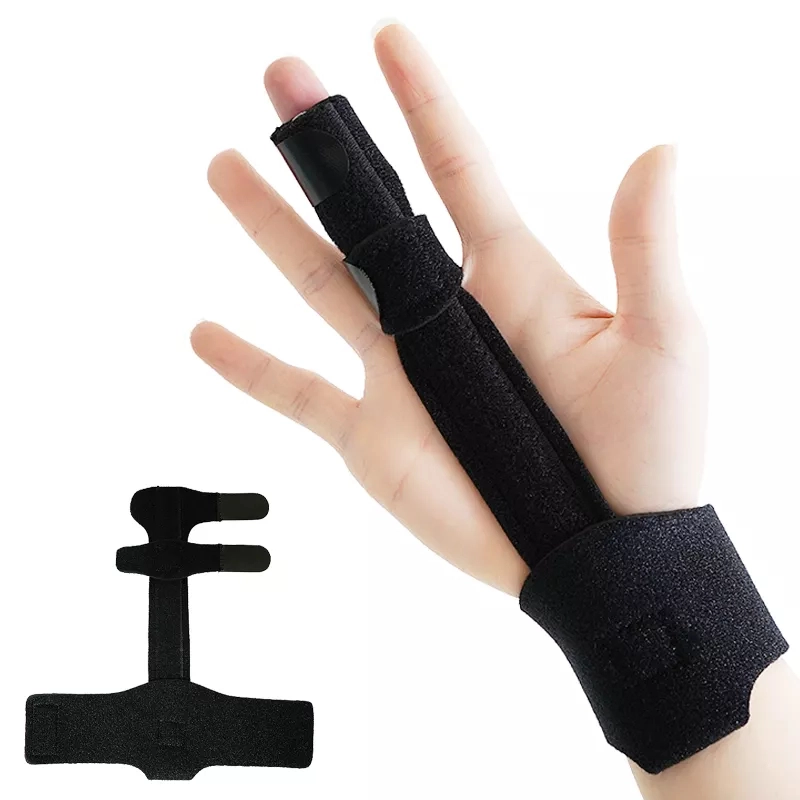
RevitaFit™ Splint Support Brace
The RevitaFit Splint Support Brace is your ideal companion for preventing, treating and easing trigger finger. Available for both men and women, this one-size-fits-all brace can be worn on any finger.
The brace features multiple adjustable Velcro straps that securely wrap around your finger and wrist. This allows for quick and easy adjustment of support, compression and fitting, tailored to your specific needs.
Incorporated within the brace is an inbuilt metal support splint. This feature stabilizes and holds your finger in a natural, straight and comfortable position. This helps protect your finger from movement and strain, improving the healing process and speeding up your recovery.
The RevitaFit Splint Support Brace applies targeted compression to your wrist and finger. This stimulates blood vessels and arteries, maintaining a constant flow of blood to your injured finger. This helps aid the natural healing process of damaged cells, reduce inflammation and swelling, and ease aches and pains deep within your knuckles.
Beyond healing support, the brace can also be worn to strengthen and improve the mobility of your injured finger. This helps bolster your rehabilitation and return your finger to its full strength and functionality.
The brace is made from premium materials that are soft, skin-friendly and durable. They feature moisture-wicking and antibacterial properties that ensure long-term comfortable wear without causing rubbing, chafing or skin irritation.
For your peace of mind, the RevitaFit Splint Support Brace comes with a full 30-day money-back guarantee!
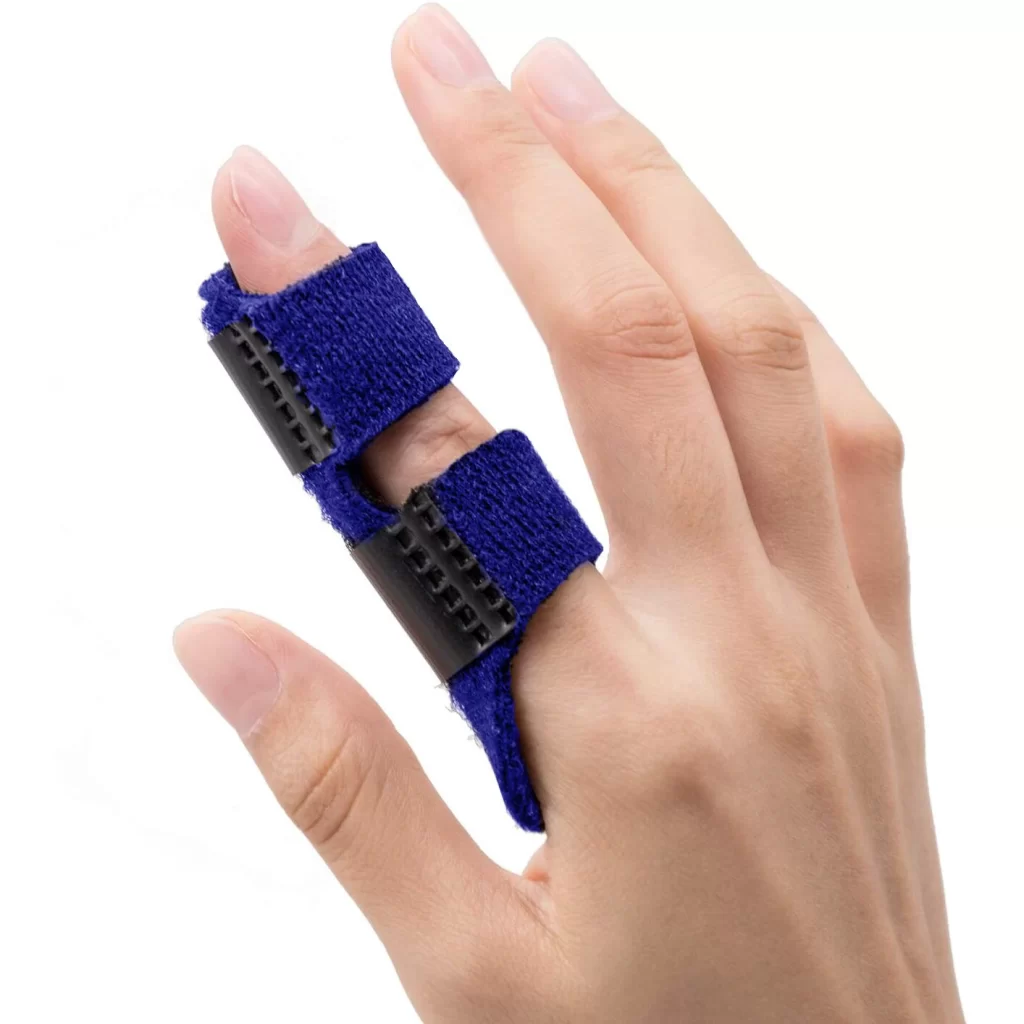
NuovaHealth™ Trigger Finger Splint
Introducing our top-of-the-line Trigger Finger Splint, expertly designed for both men and women. This essential tool for injury recovery is supremely affordable at just £6.99, making it a must-have for anyone experiencing finger-related discomfort.
This one-size-fits-all splint offers the ultimate in convenience. No matter your size, it’s quick and easy to put on and adjust for the perfect fit, level of support, and compression.
Our Trigger Finger Splint comes equipped with a removable, aluminium metal splint. This key feature serves to straighten and immobilize not only the finger but also the knuckles, providing immediate relief and promoting a quicker recovery.
Specially recommended for a variety of conditions including trigger finger, mallet finger, broken or fractured finger, sprained knuckles, rheumatoid arthritis, post stroke finger curling, post-operative care, tendonitis and for general finger pain relief.
Ensuring your comfort is our priority. This lightweight splint is designed with a soft padded interior and breathable fabric, enabling you to comfortably wear it for the entire day.
Our Trigger Finger Splint also provides soothing compression to alleviate aches and pain. By boosting blood flow to your finger, it speeds up the natural healing process so you can get back to doing the things you love faster.
We are so confident in the effectiveness of our product that we are offering a 30-day money-back guarantee. Try it today and experience the relief!
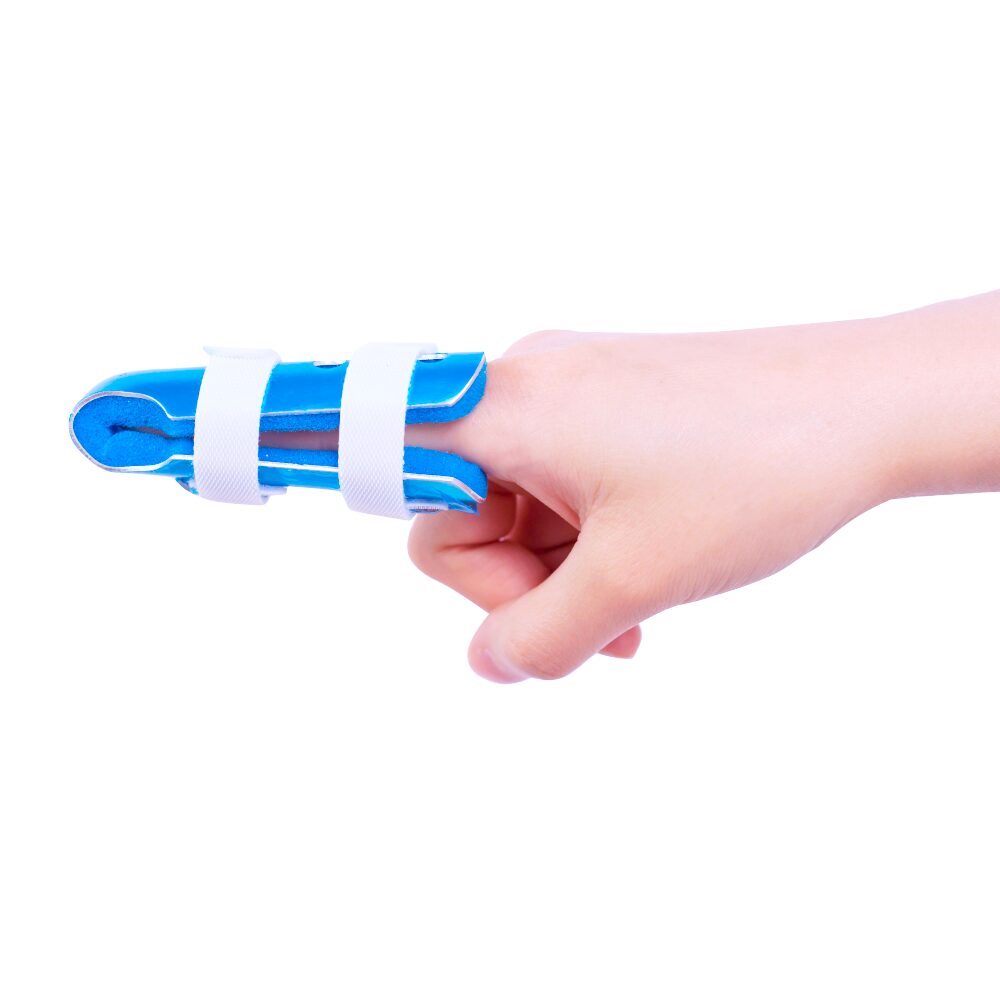
NuovaHealth™ Mallet Finger Splint
Experience the superior support and comfort of our Mallet Finger Splint Brace, a must-have for those suffering from a range of finger injuries and conditions. This unisex splint brace is available in both small and large sizes, each with an adjustable Velcro strap, ensuring a snug fit on any finger.
Designed with the user in mind, this Mallet Finger Splint Brace is recommended for the treatment and relief of conditions such as Mallet Finger, Trigger Finger, fractures, joint strains, tendonitis, gout and arthritis. It’s also ideal for managing stiffness, sprains, and broken fingers, serving as a valuable tool to help you regain your dexterity.
Featuring easy-to-use adjustable hook and loop straps, the brace stays securely in place, while giving you the flexibility to adjust the fit and level of support to your preference. The aluminum splint offers strength and stability, helping to realign and straighten your finger bones and joints in a neutral position.
Our Mallet Finger Splint Brace is perfect for following the P.R.I.C.E injury recovery protocol, protecting and compressing your finger after an injury. The brace offers soothing compression that enhances circulation, thereby reducing inflammation and swelling. This not only eases aches and pains, but also promotes healing of damaged tissue.
Made from breathable, lightweight materials with a soft memory foam interior, this splint brace ensures your finger is cushioned, providing utmost comfort for extended wear.
We stand behind the quality of our products, which is why we offer a full 30-day money-back guarantee. Try our Mallet Finger Splint Brace today and experience a new level of comfort and support for your fingers!
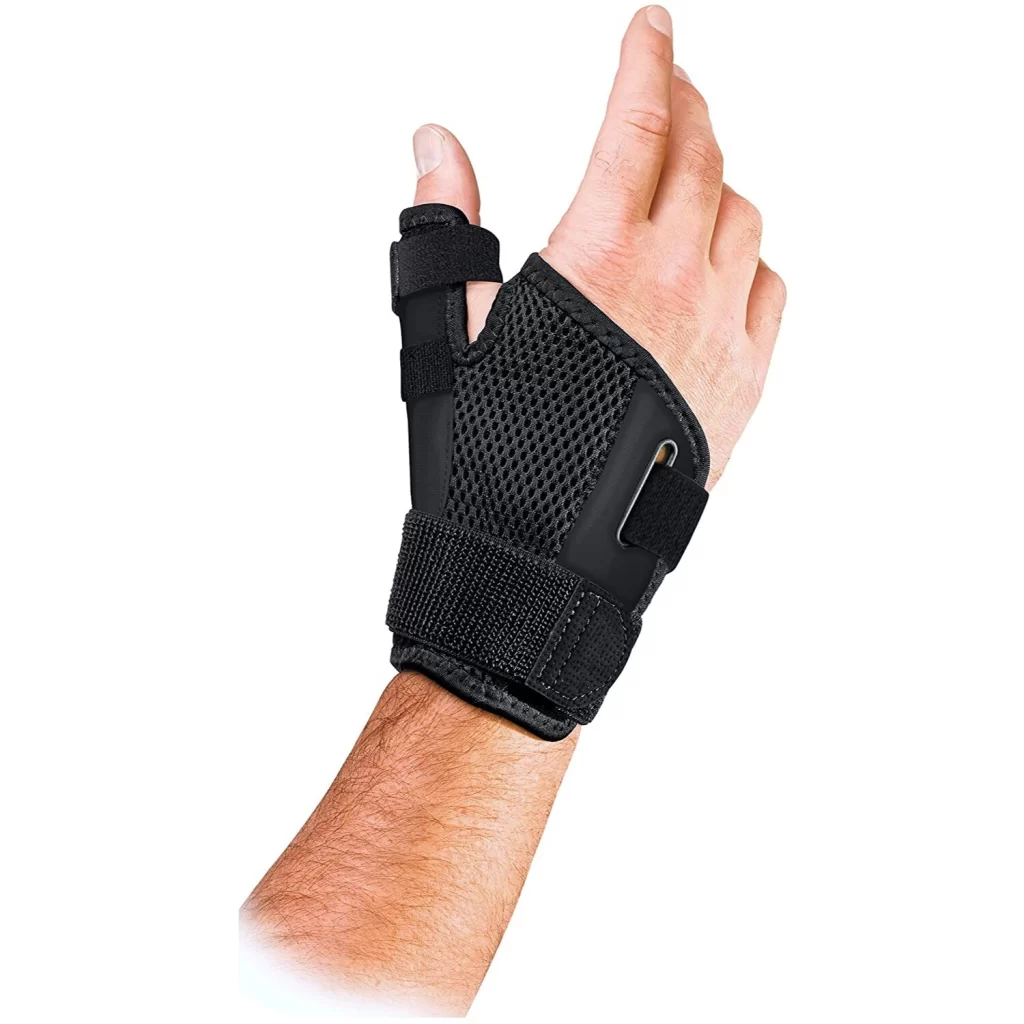
NuovaHealth™ Thumb Brace Splint
Introducing our one-of-a-kind NuovaHealth Thumb Brace Splint, expertly designed for faster, more effective recovery for those battling trigger thumb. This innovative product caters to all, with its universal fit that suits both men and women and is adaptable to the left or right hand.
The thumb brace splint comes equipped with fully adjustable Velcro straps, allowing for a tailored fit and optimal support. Unique to our design is a metal spica splint that strategically restricts thumb and wrist movement, fostering a more effective healing process.
But that’s not all. Our thumb brace splint delivers soothing, targeted compression to alleviate aches and pains, stimulating blood circulation to speed up the body’s natural healing process. The soft padding cushions your hand and wrist, providing both comfort and protection against shock. Ideal for extended wear, the inner padding is complimented by ventilation holes that improve airflow, preventing sweat and odor build-up.
This product is not only perfect for treating trigger thumb, but also for addressing fractures, sprains, strains, arthritis, and carpal tunnel syndrome. Despite its robust capabilities, our thumb brace splint boasts a lightweight, non-bulky design that doesn’t interfere with sports use or gym workouts.
We are confident in the performance of our product and offer a full 30-day money back guarantee. Place your trust in NuovaHealth’s Thumb Brace Splint, the recovery aid that truly understands your needs.
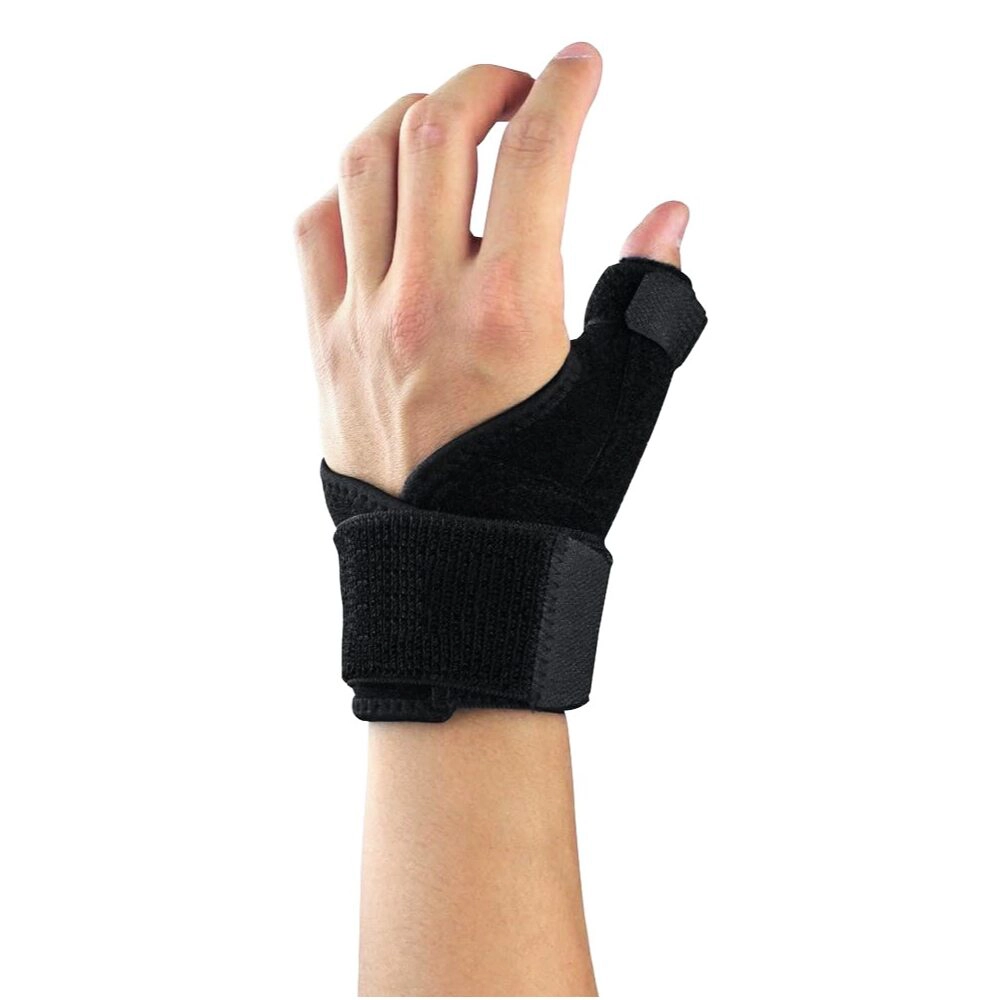
NuovaHealth™ Thumb Spica Support
Looking for a way to relieve your trigger thumb? Let us introduce you to our Thumb Support Spica Brace – a perfect blend of comfort, protection, and healing, tailored for both Men and Women.
This one-size-fits-all support is equipped with Velcro straps around the wrist and thumb. This design allows you to adjust the fit quickly and easily, giving you the right support exactly when you need it.
But that’s not all. It’s recommended not only for trigger thumb but also for easing Arthritis, Tendonitis, Carpal Tunnel Pain Relief, and all Thumb Fractures, Sprains and Strains. So, rest assured, it’s much more than just a thumb brace, it’s your go-to solution for various ailments.
The brace features a metal support splint that holds and immobilizes your thumb in a straight position. This mechanism effectively stabilizes and protects the joints in your thumb, preventing movement that can cause further damage and injury while your thumb heals.
It also offers soothing compression that increases the supply of oxygen-rich blood to your thumb, wrist, and hand. This helps in speeding up the natural healing process of damaged tissues, reducing swelling and inflammation, and easing aches and pains.
Designed with ergonomics in mind, it is lightweight, non-bulky, and comfortable to wear for long periods of time, while sleeping, exercising, or even playing sports.
Crafted from breathable moisture-wicking materials, it ensures that your thumb and hand remain dry and free from sweat while wearing the splint.
Your satisfaction is vital to us, and this is why we offer a full 30-day money-back guarantee. So, try our Thumb Support Spica Brace today and see the difference for yourself.
Disclaimer:
This article is intended to be a helpful guide for those suffering from trigger finger and looking for possible solutions. However, it’s important to remember that this advice should not replace a consultation with a healthcare professional. If you’re experiencing persistent pain or have sustained an injury to your finger or hand, we strongly recommend you seek immediate medical attention.
We have complete confidence in the quality and efficiency of our products at NuovaHealth, but we also understand that each individual’s needs may vary. While finger splints and braces can provide relief, they should always be chosen with care. Incorrect usage or improper support can lead to additional complications, including further injury.
Your health is our top priority, and we recommend you discuss your symptoms and treatment options with a trained medical professional before purchasing a splint or brace. If you’re unsure whether a product is right for you, it’s best to consult your healthcare provider.
Furthermore, the NuovaHealth team is always here to answer any questions you might have. Please feel free to reach out to us should you need further guidance or information. Please remember, while we strive to provide accurate and up-to-date information, the content of this article should not be used as a substitute for professional medical advice, diagnosis, or treatment. Your health and wellbeing is paramount. Always seek professional medical advice when needed.